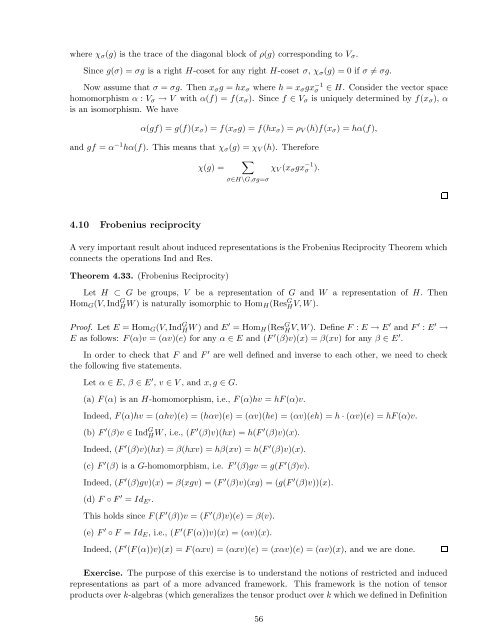Lecture notes for Introduction to Representation Theory
Lecture notes for Introduction to Representation Theory
Lecture notes for Introduction to Representation Theory
You also want an ePaper? Increase the reach of your titles
YUMPU automatically turns print PDFs into web optimized ePapers that Google loves.
where ν ε (g) is the trace of the diagonal block of δ(g) corresponding <strong>to</strong> V ε .<br />
Since g(ε) = εg is a right H-coset <strong>for</strong> any right H-coset ε, ν ε (g) = 0 if ε ⇒ = εg.<br />
Now assume that ε = εg. Then x ε g = hx ε where h = x ε gx − ε 1 H. Consider the vec<strong>to</strong>r space<br />
homomorphism ϕ : V ε ⊃ V with ϕ(f) = f(x ε ). Since f V ε is uniquely determined by f(x ε ), ϕ<br />
is an isomorphism. We have<br />
ϕ(gf) = g(f)(x ε ) = f(x ε g) = f(hx ε ) = δ V (h)f(x ε ) = hϕ(f),<br />
and gf = ϕ −1 hϕ(f). This means that ν ε (g) = ν V (h). There<strong>for</strong>e<br />
<br />
ν(g) =<br />
ν V (x ε gx − ε 1 ).<br />
εH\G,εg=ε<br />
4.10 Frobenius reciprocity<br />
A very important result about induced representations is the Frobenius Reciprocity Theorem which<br />
connects the operations Ind and Res.<br />
Theorem 4.33. (Frobenius Reciprocity)<br />
Let H → G be groups, V be a representation of G and W a representation of H. Then<br />
G<br />
Hom G (V, IndH W ) is naturally isomorphic <strong>to</strong> Hom H (Res G V, W ).<br />
Proof. Let E = Hom G (V, Ind G H W ) and E = Hom H (Res G H V, W ). Define F : E ⊃ E<br />
and F : E<br />
⊃<br />
E as follows: F (ϕ)v = (ϕv)(e) <strong>for</strong> any ϕ E and (F (α)v)(x) = α(xv) <strong>for</strong> any α E .<br />
In order <strong>to</strong> check that F and F are well defined and inverse <strong>to</strong> each other, we need <strong>to</strong> check<br />
the following five statements.<br />
Let ϕ E, α E , v V , and x, g G.<br />
(a) F (ϕ) is an H-homomorphism, i.e., F (ϕ)hv = hF (ϕ)v.<br />
Indeed, F (ϕ)hv = (ϕhv)(e) = (hϕv)(e) = (ϕv)(he) = (ϕv)(eh) = h · (ϕv)(e) = hF (ϕ)v.<br />
(b) F (α)v IndH G W , i.e., (F (α)v)(hx)<br />
= h(F (α)v)(x).<br />
Indeed, (F (α)v)(hx) = α(hxv) = hα(xv) = h(F (α)v)(x).<br />
(c) F (α) is a G-homomorphism, i.e. F (α)gv = g(F (α)v).<br />
Indeed, (F (α)gv)(x) = α(xgv) = (F (α)v)(xg) = (g(F (α)v))(x).<br />
(d) F ∞ F = Id E ⊗ .<br />
This holds since F (F (α))v = (F (α)v)(e) = α(v).<br />
(e) F ∞ F = Id E , i.e., (F (F (ϕ))v)(x) = (ϕv)(x).<br />
Indeed, (F (F (ϕ))v)(x) = F (ϕxv) = (ϕxv)(e) = (xϕv)(e) = (ϕv)(x), and we are done.<br />
Exercise. The purpose of this exercise is <strong>to</strong> understand the notions of restricted and induced<br />
representations as part of a more advanced framework. This framework is the notion of tensor<br />
products over k-algebras (which generalizes the tensor product over k which we defined in Definition<br />
H<br />
56

















